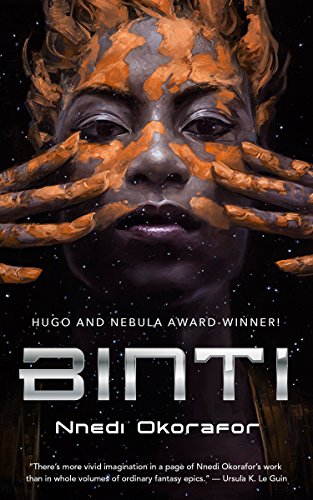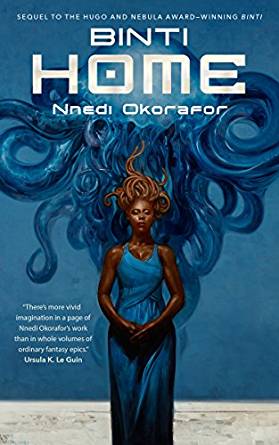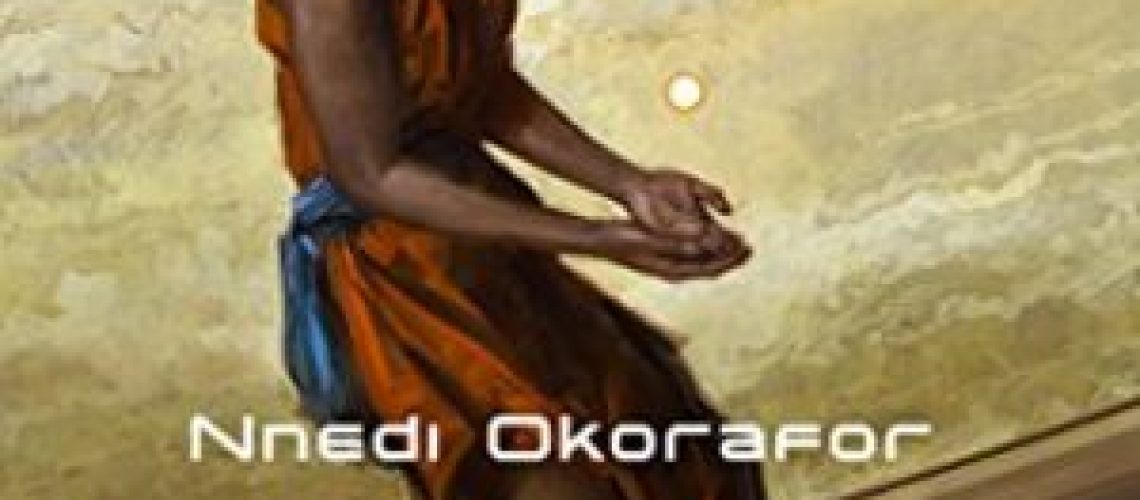Binti is a prodigy among her people, the Himba, in a mid-future world constructed by author Nnedi Okorafor. Binti’s desire to go the finest University in the galaxy breaks all sorts of norms. Binti’s like that, though, breaking norms and boundaries as she finds her way to the University, back home, and what happens thereafter. Binti’s story is told in Okorafor’s Binti, Binti: Home and the finale of the trilogy, Binti: Masquerade.

Binti, the first novella, tells of Binti’s journey to Oomza University, and the cataclysmic encounter she has on the way there, an encounter that changes her forever, and her choices ultimately drive the second two volumes. We get some detail on her Himba people origin, how she sits within that culture, and how that culture interacts with its more powerful neigbor, the spacefaring Khoush. Binti’s Himba’s status and her relationship to the Khoush are absolutely essential to understanding the plot, as Binti’s travels are interrupted by a sudden and shocking alien attack, aliens with good reason to hate the Khoush.

Binti: Home tells of the return to her home and people, facing the music of having made her unwelcome choice to go to the University. Thicker than the first volume, we dive ever deeper into her and her world and get to the root of the Matter of Binti and what her story in these volumes is shaping up to be. Binti’s actions from the first novella are reexamined, questioned, and eventually have far-ranging consquences for her people, the Khoush and the Medusae aliens.

The third volume, Binti: The Night Masquerade, which comes out as a short novel rather than a novella, picks up from the cliffhanger at the end of Binti: Home and runs with it to surprises, delights and a most fitting conclusion for her arc and her story.
The three volumes are held up as examples of Afrofuturism, with a central focus on a mid-future African experience of a mankind in contact with the rest of the galaxy. I can’t tell whether this is a future where African polities have risen to pre-eminence in our future, or a world where it has always been so. Binti’s concerns and settings never touch on or even mention London, New York, Moscow, Beijing, Dubai, Mumbai, or Brazilia. Even as we see that a rival to the Himba, the more dominant Khoush, have had a long running conflict with an alien species, I kept wondering about what the rest of the world thought about this. Surely, I thought, the rest of the world would have opinions, sides, action, in response to a culture of Earth having a potentially devastating war with an alien species. Where was the West, or the East in all this? It occurred to me, latterly, that perhaps this was the flipside of all those movies and stories where the West fights against aliens and external threats, and if a brief scene or snapshot of what happened to the rest of the world appeared, that was seemingly enough. Here, the only part of the world that matters to the story in the three volumes is a corner of southwest Africa. It is these people, these cultures that the story focuses on and cares about. It niggled at me all through the trilogy and it took adjustment for me to really grasp it as a reader.
The technology and the culture, though, were firmer ground for me as a reader. The Himba people that Binti is a part of is modeled on the Himba in Namibia and Angola, and the culture that she presents is fascinating and immersive, introducing me to her interpretation and extension of a real life people whose customs, beliefs, and practices I had had no experience or knowledge of before this. Okorafor renders this cultural tableau excellently, allowing the reader to experience a future version of a real life culture here on Earth, today, that, like me, you might never have heard of. In Binti, this is mostly seen as reflection and informing her present action. In the succeeding two volumes, mainly set on Earth, we get to be immersed in what the Himba, and their neighbors are like in real time.
And then there’s the outer space scenes. Living spacecraft are not new in Science Fiction. However, Okorafor’s take on living spacecraft and what they mean and how they act and think is evocative and thought provoking. The Medusae, the aliens that drive much of the plot of the three volumes, are an interesting species, one that Binti’s actions and choices draws her closer to on a number of levels, and so we get to see things from their point of view as well. The overall feel of the technology and its people-oriented focus is very much in keeping with the other works of the author I have read (especially Lagoon). This is not a novel for cold equations of thermodynamic regulation of the orichalcum pressure regulators, it’s a novel about how technology, not usually described in technological nuts and bolts, affects and works with people and how they interact and work with it. Binti’s family, as an example, makes astrolabes, which are computational and information devices, but how they precisely work and their exact capabilities are not what the author is interested in and not what we get as a reader.
The real core of the three novellas though is not so much the worldbuilding as it is the personal and singular development and journey of Binti herself, and it is here where the questions I had fell away as I was immersed in her story. As mentioned above, her interactions with her family, the Khoush, and most especially the Medusae all together grow, challenge and change Binti again and again. This is a coming of age story for her, and while some writers might have been contented with one big change (the trip to University), the author here puts Binti through a rapid and kaleidoscopic set of changes that drives the plot in an organic and sometimes unexpected way. Usually, for me, it is plot that will make a book a page turner — what will happen next. Here, it was, what choice will Binti make or be faced with now that kept me turning pages. Binti is curious, impulsive, determined, complex, makes mistakes, grows, develops and is everything one could hope for in a main character who drives the plot. I loved the little details that made her character complete, like her habit of thinking in equations as a response to reduce her internal stress and distress.
I recently watched Black Panther, and was delighted to see the same sort of vision of a high-tech Africa colliding, collaborating and combining with traditional culture that we get in the Binti books. I can’t be certain (I really need to see it AGAIN) but I think I even saw otjize, the traditional clay that Binti uses on her hair, on the hair of one of the actresses we see on screen. Viewers who loved the movie Black Panther should and will be delighted by the vision of the future we get in the Binti trilogy.
The Binti Trilogy is some of the best in Science Fiction being written today.







